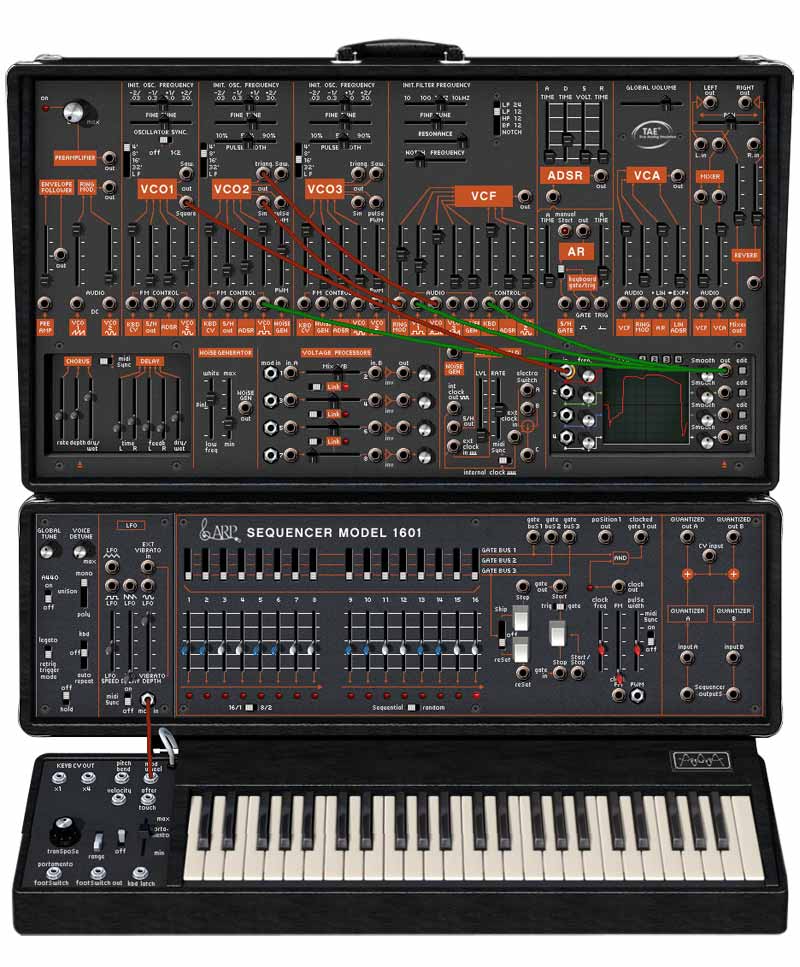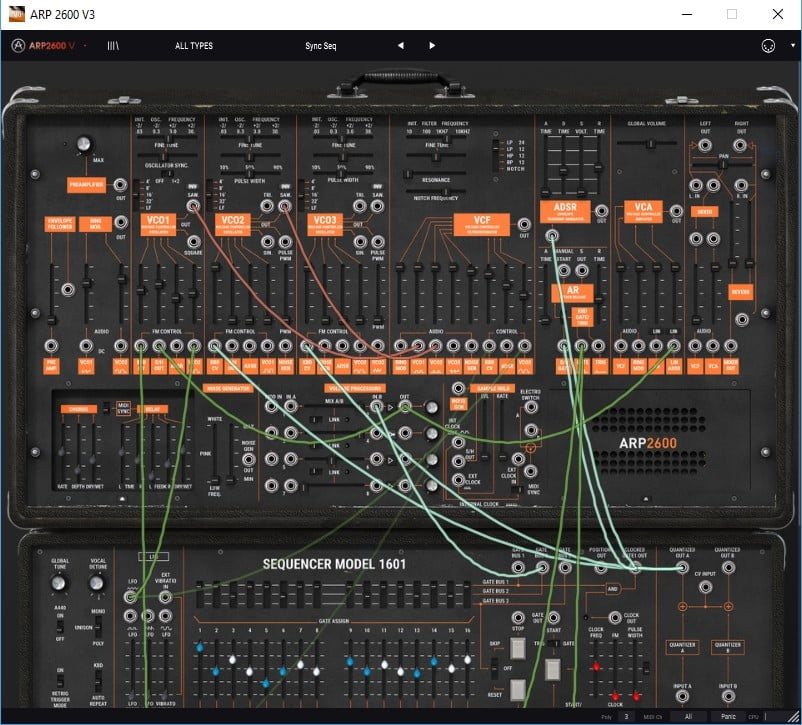Year / Date of Issue : 04.2018
Version : 3.3.0.1391
Developer : Arturia
Developer’s site : Arturia
Format : STANDALONE, VSTi, VSTi3, AAX
Bit depth : 32bit, 64bit
Tabletka : cured
System requirements : Win 7+ (64bit) PC: 4 GB RAM; 2.5 GHz 10.10+: 4 GB of RAM; 2.5 GHz CPU.
OpenGL 2.0 compatible GPU
Description : Due to its sound palette, which varies from heavy drum n ‘bass to stunted arpeggiated lines of electronic bass, regardless of your chosen genre. The 2600 is truly a universal tool for creating sound that still takes its place in modern music. Due to the unique combination of semi-modular architecture and associated routing, the tool has become one of the most versatile synthesizers of the 1970s.
The legend returned : Arp 2600 had a cult sound, and Arturia was accurate in recreating this amazing synthesizer. From the sound of three oscillators to the original filter and the huge possibilities of modular routing. You get all this and more.
Sound Research : If you’re new to the synthesis – no problem: we’ve included hundreds of great presets so you can get started. Arp 2600 is a workhorse that can produce everything from clean leads and sequencing to insane sound effects. When you need something with a special nature of sound, Arp 2600 is just what you need!
Outside and back : Although the original instrument was amazing, we always find ways of innovation and improvement. Four revolutionary modulation generators add sound flexibility, and a step sequencer will allow you to animate your sounds. Multimode filter and sound effects add new features not found in the original … Did we mention that it is completely polyphonic?
A bit of history : Alan R. Pearlman, whose abbreviation later became the name of his company, was convinced of the possibility of using electronic devices as musical instruments back in 1948, when he was a student at the Worcester Polytechnic Institute. It was for him a means to connect his two passions: electronic music and piano. In 1969, he created ARP Instruments (originally called Tonus Inc.) with David Frends and Lewis G. Pollock. In Massachusetts, electronic products were developed, but most importantly, they designed and built a large ARP 2500 modular synthesizer. The machine used a matrix to connect various sections of the synthesizer in place of the traditional connecting cables found in the competitors’ modules. ARP 2500 found success in American universities. The development of ARP-tools was fast and in 1972 ARP 2600 was announced, probably the most legendary of the whole range. This semi-modular synthesizer, conceived with an educational purpose, was to become extremely successful after a shaky start. The ARP 2600 was very popular with Stevie Wonder, Joe Zawinul (Weather Report), Tony Banks (Genesis), Jean-Michel Jarre and Herbie Hancock, and others. ARP was the leader in the synthesizer market in the 1970s (about 40% market share). Ten years later, three versions of the ARP 2600 were introduced: the first was called “Blue Meanie” because of its blue steel finish. “Blue Meanie” was quickly replaced by a second version with gray trim and white silk lines (1972). In 1978, ARP decided to change the graphic finish for all of its machines: a black background with orange silk lines was introduced. The third and last version of ARP2600 was the most popular of all.
New features : ARP 2600 V Arturia revives this powerful analog synthesizer again. All original functions and proprietary sound are reproduced, not to mention MIDI control, polyphony and the ability to create, save and play presets. But that’s not all: the speaker panels hide innovative features that raise the original design of the ARP 2600 to a new level. Four revolutionary generators add sound flexibility, which is very advanced. Also available are modern effect devices, as well as the original ARP-sequencer. The combination of old and new features creates an exciting new virtual synthesizer. If you are new to the synthesis – no problem: we have included hundreds of excellent presets so you can start. If you are an experienced sound engineer, the ARP 2600 V will immediately add new dimensions to your music.
ARP 2600 emulation. Way Out Ware presents the one and only ARP 2600 emulation endorsed by the original ARP 2600 inventor! For nearly 4 decades, the ARP 2600 has helped to provide the backbone for electronic, urban, and popular music. Oct 11, 2018 October 11, 2018 Arturia Mac Synths VST 38 V Collection 6: Buchla Easel V, DX7 V, CMI V, Clavinet V, Analog Lab, B-3 V, Mini V, Piano V, Stage-73 V, Matrix-12 V, Farfisa V, Solina V, SEM V, Wurli V, Jup-8 V, ARP 2600 V, CS-80 V, Prophet V, VOX Continental V, Modular V. The ARP 2600 was notably used by Stevie Wonder, Joe Zawinul (Weather Report), Tony Banks (Genesis), Jean-Michel Jarre, Herbie Hancock, and many others. ARP was the market leader in synthesizers during the 70s, with around 40% of the market share. Oct 05, 2009 Free ARP 2600 Software Synthesizer For Windows. This is a demo video for the Arppe2600va, a free Windows software synth designed to emulate the ARP 2600 vintage synthesizer. Based on ARP’s legendary semi-modular analog monosynth! This amazing softsynth sounds very close to the original ARP 2600. Like the original, it’s a monosynth (no polyphony).
Sponsored Links
Arturia – ARP 2600 V3 3.3.0.1391 (STANDALONE, VSTi, VSTi3, AAX) Win x86 x64. Arp 2600 is a workhorse that can produce everything from clean leads and sequencing to insane sound effects. When you need something with a special nature of sound, Arp 2600 is just what you need! Arturia ARP 2600 V THE MAGIC MIX. With its sound palette varying from heavy drum n’ bass stabs to angular arpeggiated electro bass lines, whatever your chosen genre, Arturia ARP 2600 V is a truly versatile sound creation tool which still takes its place at the heart of today’s music. Arturia ARP 2600 V3 v3.3.0.1391 Free Download Latest Version for Windows. It is full offline installer standalone setup of Arturia ARP 2600 V3 v3.3.0.1391 Crack mac for 32/64. Arturia ARP 2600 V3 v3.3.0.1391 Overview The Magic Mix With its sound palette varying from heavy drum n’ bass stabs to angular.
Key Features:
All the parameters of the original ARP 2600:
3 voltage-controlled oscillators
Osc2-> Osc1 synchronization
24 dB / octave low pass resonant filter with self-oscillation
1 LFO (can be synchronized to the host sequencer’s tempo)
1 sample and hold, 1 ring modulator, 1 noise generator
1 ADSR & 1 AR envelope follower
ARP2500 multimode 12 dB / octave filter with LP, HP, BP and Notch settings
Original ARP Sequencer model 1601
4 exclusive tracking generators with real-time interactive LFO creation ability
Voltage processors can be used as inverters, mixers or lag processors
Onboard effects: chorus, MIDI-syncable stereo delay, reverb
Polyphony from 2 to 32 voices with Unison options
More than 500 presets from the top sound designers
Absolutely pure, top quality sound from TAE® analog modeling
Related posts:
- Arturia
- ARP 2600 V
- v3.3.0.1391
- AU/VST/VST3/AAX/Standalone
- Mac OS X
Arturia ARP 2600 V THE MAGIC MIX
With its sound palette varying from heavy drum n’ bass stabs to angular arpeggiated electro bass lines, whatever your chosen genre, Arturia ARP 2600 V is a truly versatile sound creation tool which still takes its place at the heart of today’s music.
The birth of ARP Instruments and the ARP2600
Alan R. Pearlman, whose initials would form the name of ARP Instruments, became interested in instruments for electronic music as early as 1948, when he was a student at the Worcester Polytechnic Institute. This was a means for him to associate his two passions: electronic music and the piano.
It was by commercializing the amplifier models for the NASA Gemini and Apollo programs that he would start his career. Around 1968 he started seriously imagining the possibility of building electronic instruments – after hearing a recording of “Switched-on Bach,” according to legend.
In 1969, Alan R. Pearlman, David Friend and Lewis G. Pollock created ARP Instruments (originally called Tonus Inc.). The company, based in Newton Highlands (Massachusetts, USA), conceived electronic products, but also and above all else a large modular synthesizer, the ARP 2500. The machine used a matrix which connected the different sections of the synthesizer, instead of the traditional cables found in its competitor’s modular system. The ARP 2500 found success in American universities.
Used by most famous artists
The growth of ARP instruments was fast and in 1972 the ARP 2600, probably the most legendary of the entire range, was unveiled. This semi-modular synthesizer, conceived with an educational goal, was to become hugely successful after a shaky start. The ARP 2600 was notably used by Stevie Wonder, Joe Zawinul (Weather Report), Tony Banks (Genesis), Jean-Michel Jarre, Herbie Hancock… ARP was the market leader in synthesizers during the 70’s with around 40% of the market share.
In ten years, three versions of the ARP 2600 were commercialized: The first version was called “Blue meanie” because of its steely blue finish. The “blue meanie” was quickly replaced by a second version, with a grey background finish and white silk screening (1972). This was to be more popular. In 1978 ARP decided to change the graphic chart for all of its machines: a black background color with orange silk screening was introduced. The ARP2600 benefited from its third and last version.
The great rival
The great rival of ARP was the Bob Moog’s company. The competition between the two manufacturers can easily be seen when we observe the machines: The ARP, for example, has linear potentiometers, while its competitor has rotating pitch bend and modulation wheels.
A well-known episode of this competition was the 24 dB/octave filter, the 4012, used by the ARP. This was a replica of the famous filter made by its competitor. In 1973, this one threatened ARP with legal action and the firm decided to change the circuits on its filter. The 4072 was born and took the place of the 4012. This possessed a calibration error in the high frequencies – the maximum cut-off frequency was less than 11 kHz instead of the 16 kHz promised in the press. Luckily the repair for users was fast and not much of a burden. On the first ARP 2600’s, the 4012 filter was still used (this was the case for the “Blue meanie” and on the first examples of the “grey and white”) while the models that followed offered the 4072.
The ARP synthesizers possess very stable oscillators, more reliable than the ones equipping Bob Moog’s synthesizers, what he admitted himself. On the other hand, ARP for a long time dipped the electronic circuits for filtering in resin to avoid industrial piracy… this made for major problems when trying to perform a repair.

Arp 2600 Vst Crack Mac
In 1972, ARP launched the Odyssey, which would be in direct competition with the Bob Moog’s monosynth released one year earlier. The same year, the Pro-Soloist, a preset instrument, was also unveiled.
In 1976, ARP released a small 16 step sequencer in the form of 2 independent 8 step sequences. This became famous and is still very sought after (it is emulated in the Arturia ARP 2600 V) The same year they presented the Omni, which would become one of ARPs biggest successes. The instrument allowed the combination of two polyphonic violin sounds – a great innovation for the company – and 2 monophonic bass sounds.

Arp 2600 Vst Crack Software
But in 1981, ARP was finally bought out by CBS. The following year, CBS with part of the ARP development team would produce the Chroma, a programmable polyphonic synthesizer, and in 1984 the Chroma Polaris, a simplified and MIDIcapable version of the Chroma.
Comments are closed.